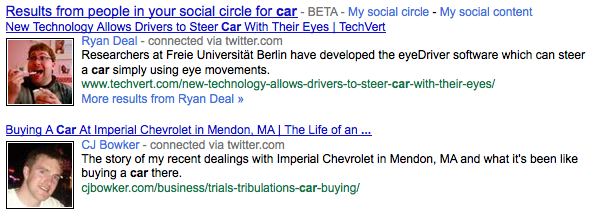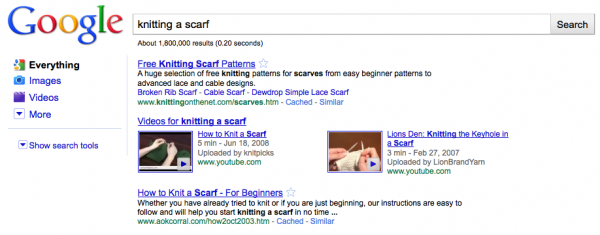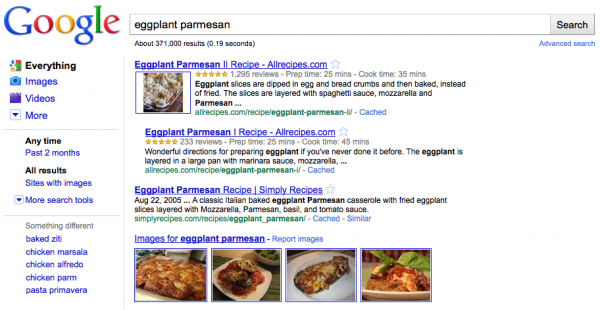Make social media part of your plan for SEO campaign management
Most social media sites use “nofollow” tags. This basically means that an inbound link from this site isn’t going to do your Google juice any good and you won’t get any valid inbound links from it.
So why do we even bother thinking about SEO when it comes to social media? Well because Google gives social networks preferential treatment in rankings.
Have you ever noticed that YouTube videos show up above the fold on page one in Google? This gives you the opportunity to upload videos and get ranked on page one with terms you may never have gotten ranked on before. It’s actually still fairly easy to get a page one ranking with a YouTube video if you choose your keywords right. Once you’ve done your keyword research, try uploading a few videos targeting that term in the title and description to see if you rank.
Example: Search “Knitting a scarf” and these videos show up at the top of 1.8 million pages. The less YouTube videos using your designated keyword, the more successful you’ll be – just like with any type of other SEO.
Google Social Search, while still in beta, can be useful to you if you have a lot of followers. When someone who is following you searches a particular topic that you are also talking about on Twitter, your tweet or a link to your blog post will appear in their feed that contains links from their social circle. It’s at the bottom of the page, but it’s still page one!
Example: I want to look at a car site, so I type in the most basic keyword, “car”. What I get back are people I follow on Twitter who have used the keyword “car” in their recent tweets and the links go directly to the blogs they’re referring to. If you notice, these are their own blogs, so they’re doing a fine job marketing here. They get preference in search results over millions of others just because I know them.
[text_ad]

[text_ad]
I’m going to tell you right now that Facebook is a stretch when it comes to SEO, because while it’s a major social network with great pull in Google, you’re generally going to get ranked on your brand name, and what you really want is people going to your site anyway. However, if you want people to find you on Facebook, make sure you have over 100 fans so that you can get a custom URL. Add keywords if you so desire. In your page description, also use keywords and add high priority links.
One way that pulls all of the tips here together that can also work for Facebook is to make sure all of your images have captions, your events have descriptions, and add a discussion forum. Google indexes all of these things, and with Facebook backing you, it will be even easier to get into Google images, videos and content results.
One last tip is to upload your own pictures into your blogs. If you can help it, don’t use images from other sites, try to do your own photography. You’d be surprised at the pictures that show up in Google images ahead of well-known publishing brands, and instead come from small, low-traffic blogs. This is why it’s especially important to name the photos in your articles after the keywords in your article.
Example: Every single one of these pictures that show up in Google for Eggplant Parmesan below have the words “Eggplant” and “Parmesan” in the file name. Google images is possibly one of the best places to show up in results because it brings the reader right to your site.







Hello,
I’m glad to find an article on Search Engine Optimization strategies in your website.
I share your view on this and I’d like to share a proven strategy that could further enhance your marketing campaign using followups. I wrote something about it in my blog and if you are interested, you can visit it.
I wish you can drop by and see for yourself.
Have a good day.
Justin